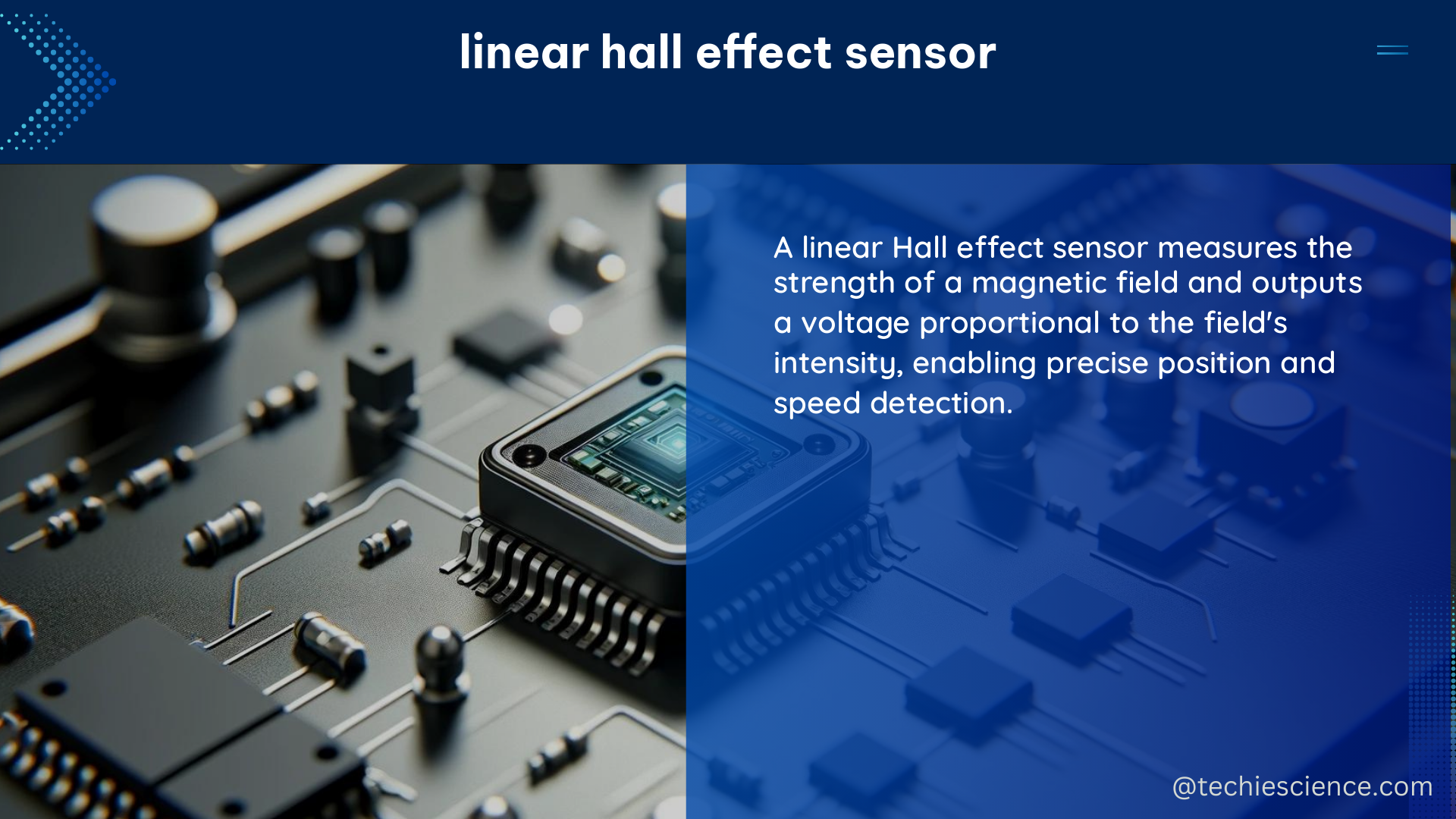The Linear Hall Effect Sensor is a versatile and precise device that measures magnetic fields and converts them into an electrical signal. This sensor operates on the principle of the Hall Effect, which is the production of a voltage difference across an electrical conductor when a magnetic field is applied perpendicular to the current flow.
Understanding the Fundamentals of Linear Hall Effect Sensors
Linear Hall Effect Sensors are designed to provide a linear output voltage that is proportional to the strength of the applied magnetic field. The sensor’s output voltage can be expressed as:
V_out = V_offset + S * B
Where:
– V_out is the output voltage of the sensor
– V_offset is the offset voltage
– S is the sensitivity of the sensor
– B is the strength of the applied magnetic field
The sensitivity of the sensor, S, is typically expressed in millivolts per gauss (mV/G) or millivolts per tesla (mV/T), depending on the units used to measure the magnetic field.
Factors Affecting the Accuracy of Linear Hall Effect Sensors

The accuracy of a Linear Hall Effect Sensor is influenced by several factors, including:
-
Physical Setup: The spacing between the sensor and the magnet is a critical factor. When using a single sensor, the accuracy is approximately equal to the spacing multiplied by 8. For example, if the spacing is 1 mm, the accuracy would be around 8 mm.
-
Magnet Selection: The choice of magnet used with the sensor can significantly impact the accuracy. Factors such as the magnet’s strength, size, and orientation can all affect the magnetic field distribution and, consequently, the sensor’s output.
-
Single vs. Dual Sensor Configuration: Using two sensors placed 90 degrees apart can improve the accuracy and eliminate the need for a calibration phase. In this configuration, the sensor output voltage takes a specific form, and the peak amplitude is unknown, but the angle can be determined more accurately.
Calibration and Compensation Techniques
To ensure accurate measurements, a lookup table calibration implementation can be used. This approach involves the following steps:
- Data Collection: Record the sensor voltage data for known angles of the magnetic field.
- Lookup Table Creation: Construct a lookup table that maps the recorded sensor voltages to the corresponding angles.
- Linear Interpolation: During normal operation, use linear interpolation between the known voltages in the lookup table to determine the angle for any measured voltage.
This calibration technique can effectively compensate for factors that affect the sensor’s accuracy, such as physical setup, magnet selection, and sensor configuration.
Advanced Applications and Considerations
Linear Hall Effect Sensors find applications in a wide range of industries, including:
- Automotive: Throttle position sensing, steering angle measurement, and gear position detection.
- Industrial Automation: Rotary and linear position sensing, speed and direction monitoring, and current sensing.
- Consumer Electronics: Joystick and gamepad control, lid and door position detection, and proximity sensing.
When designing systems with Linear Hall Effect Sensors, it’s essential to consider the following factors:
- Temperature Compensation: The sensor’s output can be affected by temperature variations, so temperature compensation techniques may be necessary to maintain accuracy across a wide temperature range.
- Noise Reduction: Electromagnetic interference (EMI) and other noise sources can impact the sensor’s performance, so proper shielding and filtering techniques may be required.
- Power Consumption: Depending on the application, power consumption may be a critical factor, and low-power sensor options may be necessary.
Conclusion
The Linear Hall Effect Sensor is a powerful and versatile tool for measuring magnetic fields and converting them into electrical signals. By understanding the fundamental principles, factors affecting accuracy, and advanced calibration and compensation techniques, you can effectively leverage this sensor in a wide range of applications. With the right knowledge and implementation strategies, you can unlock the full potential of Linear Hall Effect Sensors and achieve precise, reliable, and robust performance.
References:
- Texas Instruments, “Linear Hall-Effect Sensor Angle Measurement Theory, Implementation, and Calibration,” SLYA036B – JULY 2018 – REVISED NOVEMBER 2021, https://www.ti.com/lit/an/slya036b/slya036b.pdf?ts=1705354107861
- TI Precision Labs, “Hall-effect current sensing – YouTube,” 2021-09-30, https://www.youtube.com/watch?v=F_GUbKJQQug
- Honeywell, “Hall Effect Sensing and Application,” Hall Book, http://denethor.wlu.ca/pc300/projects/sensors/hallbook.pdf

The lambdageeks.com Core SME Team is a group of experienced subject matter experts from diverse scientific and technical fields including Physics, Chemistry, Technology,Electronics & Electrical Engineering, Automotive, Mechanical Engineering. Our team collaborates to create high-quality, well-researched articles on a wide range of science and technology topics for the lambdageeks.com website.
All Our Senior SME are having more than 7 Years of experience in the respective fields . They are either Working Industry Professionals or assocaited With different Universities. Refer Our Authors Page to get to know About our Core SMEs.